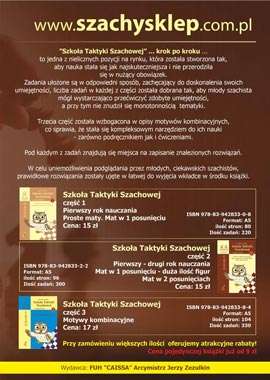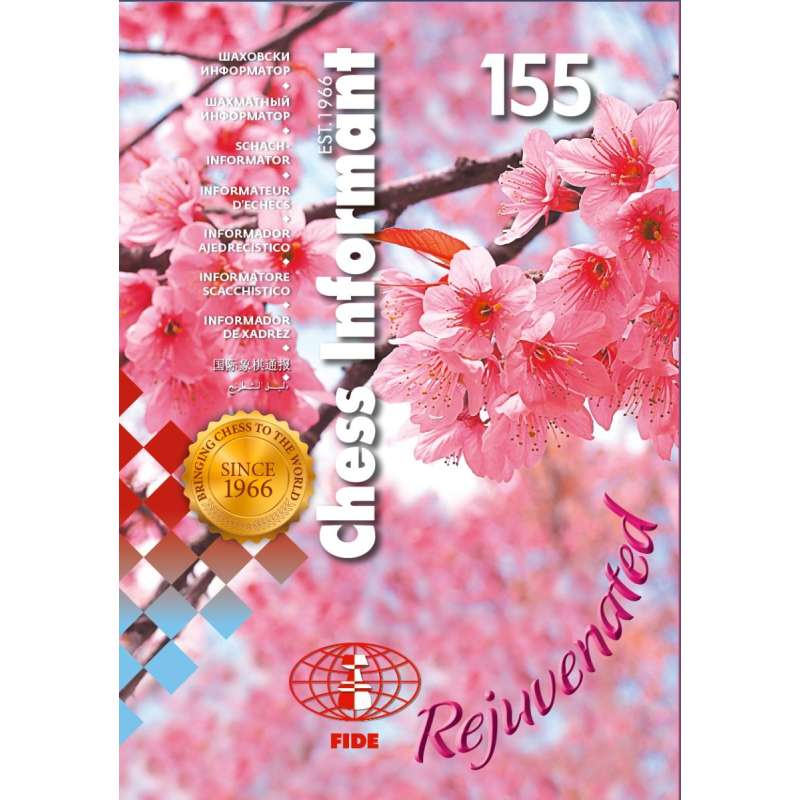Szachy Senator (S-15)
Szachownica i figury wykonane są z drewna.
Wymiary: 420 x 210 x 50 mm
Król: 78 mm
Waga 1.60 kg
Szachownica i figury wykonane są z drewna.
Wymiary: 420 x 210 x 50 mm
Król: 78 mm
Waga 1.60 kg
Nowe rozszerzone wydane - 2020 r. II wydanie., 280 str., miękka oprawa, dobra poligrafia , język polski.
Cytat I ze Wstępu: „Szybki Kurs Debiutów omawia przede wszystkim otwarcia w jednym tomie i jest przeznaczony przede wszystkim dla szerokiej rzeszy sympatyków królewskiej gry. Dzięki niej każdy może szybko zapoznać się z ogólnymi tajemnicami teorii otwarć, głównymi ideami i planami, co wydatnie pomoże w rozgrywaniu partii”.
Cytat II: „Każda faza partii, otwarcie, gra środkowa i końcowa ma duże znaczenie. Jeżeli na początku gry, któraś ze stron uzyska przewagę materialną lub pozycyjną, to zniwelować ją w grze środkowej będzie bardzo trudno. W tej sytuacji do końcówki może w ogóle nie dojść. Bez poprawnej gry w debiucie, nie można więc myśleć o sukcesach w szachach.
Kompletny zestaw dwóch części książki Mistrzowie Polski w Szachach obejmujący biografie polskich szachistów grających w latach 1926 - 2021r.
Drugie wydanie pierwszej części wspaniałej książki autorstwa czelabińskiego arcymistrza i wybitnego trenera. Pozycja ta jest wyśmienitym podręcznikiem końcówek szachowych. Autor prezentuje przede wszystkim metody i nawyki gry w końcówkach.
Najlepiej sprzedające się szachy od lat.
Najlepszy stosunek jakości do ceny.
Szachownica i figury wykonane z drewna.
SZACHOWNICA wypalana, składana na pół,
w środku znajduje się wkładka na figury szachowe
FIGURY drewniane, wypalane, podklejane zielonym filcem
Wymiary szachownicy: 54 x 54 x 3 cm
Wymiar pola: 55 x 55 mm
Król: 110 mm
Waga 2.50 kg
Najniższa cena w ciągu 30 dni przed aktualną promocją: 36,9 zł
Podręcznik kombinacji szachowych dr. Tarrasha to unikalna pozycja, która powstała w oparciu o fragment pracy
Siegberta Tarasha - „Gra w szachy” traktujący o kombinacjach.
W przeciwieństwie do innych dostępnych na rynku pozycji o kombinacjach jest nie tylko ich zbiorem,
ale także opisuje mechanizmy kombinacji oraz wyjaśnia je. Dzięki temu staje się niepowtarzalna i przydatna na każdym etapie rozwoju.
Książka jest przeznaczona dla szachistów od V do II kategorii, chociaż niektóre jej fragmenty przydadzą się także szachistom I kategorii.
SPIS TREŚCI:
005 Przedmowa
007 Wstęp
011 Rozdział 1. Podwójne uderzenie
027 Rozdział 2. Związanie
045 Rozdział 3. Atak z odsłony
051 Rozdział 4. Nie broniona figura
055 Rozdział 5. Usunięcie obrony
060 Rozdział 6. Pozorna obrona
064 Rozdział 7. Zamykanie gońca
066 Rozdział 8. Łapanie hetmana po wzięciu na b2 (b7)
068 Rozdział 9. Atak na punkt f7 (f2)
070 Rozdział 10. Atak pionem „f”
072 Rozdział 11. Odsłonięcie pozycji króla
076 Rozdział 12. Rozbita pionowa pozycja roszady
080 Rozdział 13. Gdy pion h3 (h6) jest obiektem ataku
083 Rozdział 14. Atak po linii „f"
087 Rozdział 15. Atak po linii „g” (lub „b”)
094 Rozdział 16. Atak po linii „h” (lub „a”)
105 Rozdział 17. Dwa gońce przeciw pozycji roszady
107 Rozdział 18. Niebezpieczeństwa związane z długą roszadą
108 Rozdział 19. Mat Beniowskiego
111 Rozdział 20. Mat na 1. (8) linii
118 Rozdział 21. Wieczny szach
119 Rozdział 22. Wieża na otwartej linii pionowej i na 2.(7) linii
129 Rozdział 23. Działanie liniowych figur przez nieprzyjacielskie figury
131 Rozdział 24. Wolny pion
139 Rozdział 25. Daleko wysunięte piony
143 Rozdział 26. Gdy pion c6 (c3) jest obiektem ataku
145 Rozdział 27. Gdy pion b6 (b3)
149 Rozdział 28. Trochę rad
Kompletna edycja książek z serii WESOŁE SZACHY wydana w jednym podręczniku.
Ten kompleksowy podręcznik dla najmłodszych szachistów zawiera nie tylko wszystkie 3 części "Wesołych Szachów, ale także część 4 - czyli całkowitą nowość, dotychczas nigdy nie wydaną!
1400 Kombinacji matowych - Ryszard Czajkowski, Andrzej Nowicki
----------------------------------------------------------------------------
Niniejsza książka to unikalny zbiór 1400 diagramów z praktyki szachowej mistrzów i arcymistrzów z wielu krajów i różnych epok oraz własnych przykładów samych autorów.
Stopień trudności poszczególnych zadań jest na tyle zróżnicowany, by każdy szachista czerpał radość z ich rozwiązywania, niezależnie od swoich umiejętności. Tak więc w książce znajdziemy proste i bardziej skomplikowane przykłady taktyki szachowej, klasyczne końcówki, piękne kombinacje, które na zawsze przeszły do historii szachów, studia, etiudy i kompozycje szachowe oraz odzwierciedlenie zawartych w nich idei przeniesionych do praktyki turniejowej.
Czytelnik może poznać różnorodne sposoby matowania – od najprostszych jedno i dwuposunięciowych do mata w 262 (!!) posunięciach.
 Nowy elektroniczny zegar szachowy LEAP KK9908
Nowy elektroniczny zegar szachowy LEAP KK9908
Charakterystyka zegara:
• zegar z atestem FIDE!
• opcja dodawania czasu
• 37 ustawień zegara dla szachów oraz różnych gier
• maksymalna prostota obsługi
• duży, czytelny wyświetlacz pozwala na odczytanie czasu nawet z odległości 10m!
waga: 0,2 kg
Szachownica i figury wykonane są z drewna.
Wymiary: 420 x 210 x 50 mm
Król: 78 mm
Waga 1.60 kg
Puchary drewniane w kształcie figur szachowych w dwóch kolorach. Król, wysokość 35 cm, średnica podstawy 13 cm, wysokość podstawy 2,9 cm, waga: 0,7 kg
Puchary są idealne na nagrody dla dzieci w turniejach szachowych.
Podana cena dotyczy jednej sztuki.
Firma CAISSA jest producentem szachowych pucharów drewnianych.
Istnieje możliwość hurtowego zakupu niniejszych pucharów.
W sprawie zakupu hurtowego prosimy o kontakt mailowy: juzez@go2.pl lub telefoniczny: 509 983 593
Kieszonkowe Szachy Magnetyczne w NOWEJ ODSŁONIE 2.0
Tym razem – składane na 3, dzięki czemu zyskały miejsce na "zbite" figury.
Dodatkowo wprowadzono notację, której brak czasem krytykowano w poprzedniej edycji.
Poręczny towarzysz w podróży w Twojej kieszeni!
Od dziś możesz grać w szachy gdziekolwiek i kiedykolwiek zechcesz!
- Idealne do analizy partii!
- Szachy wykonane są z tworzywa sztucznego.
- Zewnętrzna strona zrobiona została z ekoskóry.
- Materiał: Vinyl, ekoskóra, plastik
DGT 1002 to najprostszy z dostępnych na rynku zegarów szachowych z opcją "BONUS" (dodawanie czasu za wykonane posunięcie). Jest niezwykle łatwy w obsłudze i bardzo przyjemny w użyciu. Wystarczy nacisnąć + lub -, aby ustawić pożądany czas.
Ze względu na niewielki rozmiar zegara, można go postawić przy samej szachownicy nawet nawet na małej przestrzeni na stole.
Wymiary zegara:
• długość 155 mm,
• szerokość 42 mm,
• wysokość 60 mm.
DGT 1002 pracuje na tylko jednej baterii (dołączonej do zestawu).
Na zegar udzielana jest 2-letnia gwarancja.
Doskonały zegar w prostej formie, prosty w obsłudze z dużym, czytelnym wyświetlaczem - idealny dla każdego gracza.
Polecany dla szkół i klubów szachowych.
NOWOŚĆ 2022! POLSKA WERSJA JĘZYKOWA (INTERFEJS W JĘZYKU POLSKIM)
NOWA, ULEPSZONA WERSJA PROGRAMU FRITZ 18 WZBOGACONA O SILNIK POWERFRITZ ORAZ BAZĘ FRITZ POWERBOOK 2022!!
Autor przygotował materiał, który zawiera propozycje gry wariantów przeciwko debiutom zamkniętym i pół zamkniętym Każdemu debiutowi autor poświęcił tyle miejsca, na ile zasługuje ze względu na bogactwo wariantów i częstość jego występowania w praktyce turniejowej. Autor celowo ominął większość systemów z nieprzyjętego gambitu hetmańskiego, które w zasadzie powinny być obowiązkowe w repertuarze debiutowym zawodnika rozpoczynającego partię posunięciem 1.d2-d4.
Zestaw idealnie uzupełnia program nauczania "Edukacja przez Szachy w Szkole" (Książki Magdaleny Zielińskiej "Grajmy w szachy").
Seria książek ”Szkoła Taktyki Szachowej” to zestaw zeszytów ćwiczeniowych, które pozwolą krok po kroku, w systematyczny i uporządkowany sposób opanować umiejętności potrzebne każdemu początkującemu szachiście, takie jak: elementarne matowanie króla przeciwnika, zrozumienie sposobu działania wszystkich figur oraz współpracy pomiędzy nimi, a także podstawowe motywy taktyczne.
To kompleksowe narzędzie do nauki szachisty, aż do III kategorii!
Książki stanowią idealne uzupełnienie wszystkich dostępnych podręczników, m. in. Magdaleny Zielińskiej ”Grajmy w szachy”, uznanego, jako oficjalny podręcznik programu Edukacja przez Szachy w Szkole.
”Szkoła Taktyki Szachowej” ... krok po kroku ... to jedna z nielicznych pozycji na rynku, która została stworzona tak, aby nauka stała się jak najskuteczniejsza i nie przerodziła się w nużący obowiązek.
Zadania ułożone są w odpowiedni sposób, zachęcający do doskonalenia swoich umiejętności, liczba zadań w każdej z części została dobrana tak, aby młody szachista mógł wystarczająco przećwiczyć zdobyte umiejętności, a przy tym nie znudził się monotonnością tematyki.
Trzecia część została wzbogacona w opisy motywów kombinacyjnych, co sprawia, że stała się kompleksowym narzędziem do ich nauki - zarówno podręcznikiem jak i ćwiczeniami.
Pod każdym z zadań znajdują się miejsca na zapisanie znalezionych rozwiązań.
W celu uniemożliwienia podglądania przez młodych, ciekawskich szachistów, prawidłowe rozwiązania zostały ujęte w łatwej do wyjęcia wkładce w środku książki.
SZACHY TURNIEJOWE NR 5 - Wiśniowe
Drewniane figury Staunton nr 5 z drewna wiśniowego - obciążone, podklejone zielonym filcem
- Wysokość króla - ok. 90 mm;
- Wysokość pionka - ok. 45 mm
Szachownica drewniana, składana na pół z miejscem na figury w środku.
- Wymiar szachownicy: 48 x 48 x 2,7 cm;
- Wymiar pola szachowego: 48 x 48 mm;
Waga łączna: 1.7 kg;
Szachy drewniane
Wymiary: 270 x 470 x 50 mm
Król: 85 mm
Waga: 1,1 kg
SZACHY TURNIEJOWE w kolorze WENGE NR. 5
Klasyczny, profesjonalny zestaw turniejowy w rozmiarze nr 5 (48x48 cm)
Ciemny kolor zestawu sprawia, że szachy prezentują się bardzo oryginalnie.
Atrakcyjnie wyglądająca pamięć USB w kształcie króla
Wykonanie: drewno egzotyczne
Pojemność: 64 GB
Wymiary:
- wysokość: 90 mm
- średnica: 30 mm
Profesjonalny zegar szachowy z atestem FIDE (Międzynarodowej Federacji Szachowej). Najczęściej używany zegar na profesjonalnych turniejach szachowych. Sprawdzony zawodowcami przez wiele lat, jakościowy, niezawodny sprzęt szachowy.
Posiada wiele nowych rozwiązań:
- większy i bardziej czytelny wyświetlacz
- kilka dodatkowych opcji nastawienia czasu
- więcej informacji na wyświetlaczu
- łatwiejsze ustawienia
- możliwość ustawienia sygnału dźwiękowego
- oszczędne baterie(2 paluszki)
- nowoczesny wygląd
- Waga : 0,5 kg
Zegary posiadają 2 - letnią gwarancję.
TEMPA GRY dostępne w zegarze ( aż 36 opcji! w tym BYO-YOMI do GO )
Leitao – Brazilian Champion in Wijk aan Zee (Tournament Review)
Moradiabadi – Tata Steel 2023 Wijk aan Zee (Tournament Review)
Yochanan Afek – Perls from Wijk (Tournament Review)
Perunovic – Instructive positions from Wijk
Foisor – Women FIDE Grand Prix Munich (Tournament Review)
Shyam Sundar – This or that? (Instructive Lesson)
Gormally – 4NCL (Review)
Prusikin – The Uncastled King (Instructive Lesson)
Davies – The Catalan 7.dc5 (Theoretical Survey)
Kotronias – The King’s Indian 5.h3 (Theoretical Survey)
Szabo – The French C11 (Theoretical Survey)
Perelshteyn – The Ruy Lopez Nerwegian Variation (Theoretical)
Petrov – World Championship Game Changers – part 6
Rogers – Belgrade Open 1984 (Roger’s Reminiscences)
Griffin – Ljubojevic – Miles, Olympiad 1980 (From Informant Archives)
Traditional sections: games, combinations, endings, Tournament reviews, the best game from the preceding volume and the most important theoretical novelty from the preceding volume.
The periodical that pros use with pleasure is at the same time a must have publication for all serious chess students!

Gwarancja zwrotu pieniędzy

Bezpieczne i szybkie dostawy

Bezpieczeństwo transakcji dzięki certyfikatowi SSL
United Colours of Autumn
Presents 350 pages of the very best in chess:
Duda - How I won the World Cup
Ivic & Mio. Perunovic - World Cup Fairy Tale
Leitao - South Americans in the World Cup
Perunovic - Duda’s World Cup Black Repertory
Foisor - St. Louis Rapid&Blitz (Tournament review)
Moradiabadi - Sinquefield Cup (Tournament review)
Gormally - Danny’s Chess Diary (Northumbria Masters)
Priyadharshan K. - Asian Masters - Meltwater Tour (Tournament review)
Davies - Understanding the Openings (The Semi-Tarrasch part 1)
Szabo - Anti-Marshall 8.a4 d5!? (Opening Survey)
Prusikin - A Story about Horses and Elephants (Knight versus Bishop)
Petrov - World Championship Game Changers - part 1
Rogers - Reggie Emilia 1984/1985 (Rogers’ Reminiscences)
Griffin - A Tribute to Iron Tigran (Polugaevsky-Petrosian 1970.)
Traditional sections: games, combinations, endings, Tournament reviews, the best game from the preceding volume and the most important theoretical novelty from the preceding volume.
The periodical that pros use with pleasure is at the same time a must have publication for all serious chess students!
Leitao – Opening Trends in South American Chess
Moradiabadi – European Club Cup (Tournament Review)
Navara – European Club Cup – Novy Bor
Shyam Sundar – This or That? – Part 2
Gormally – 4NCL and Crypto Blitz (Tournament Review)
Marin – Benoni Files (Old Wine in New Bottles)
Kotronias – King’s Indian – Fianchetto Variation (Survey)
Perelshteyn – Dzindzi-Indian (Theoretical Survey)
Davies – The 3…g6 Ruy Lopez – Part 2 (Theoretical Survey)
Perunovic – Catalan (Theoretical Survey)
Rogers – Toluca 1982 Interzonal (Roger’s Reminiscences)
Griffin – Karpov – Timman 1981(From Informant Archives)
Traditional sections: games, combinations, endings, Tournament reviews, the best game from the preceding volume and the most important theoretical novelty from the preceding volume.
The periodical that pros use with pleasure is at the same time a must have publication for all serious chess students!
Leitao – Opening Trends in South American Chess
Moradiabadi – European Club Cup (Tournament Review)
Navara – European Club Cup – Novy Bor
Shyam Sundar – This or That? – Part 2
Gormally – 4NCL and Crypto Blitz (Tournament Review)
Marin – Benoni Files (Old Wine in New Bottles)
Kotronias – King’s Indian – Fianchetto Variation (Survey)
Perelshteyn – Dzindzi-Indian (Theoretical Survey)
Davies – The 3…g6 Ruy Lopez – Part 2 (Theoretical Survey)
Perunovic – Catalan (Theoretical Survey)
Rogers – Toluca 1982 Interzonal (Roger’s Reminiscences)
Griffin – Karpov – Timman 1981(From Informant Archives)
Traditional sections: games, combinations, endings, Tournament reviews, the best game from the preceding volume and the most important theoretical novelty from the preceding volume.
The periodical that pros use with pleasure is at the same time a must have publication for all serious chess students!
New In Chess Yearbook, which appears four times a year, contains the latest news in chess openings. Each issue brings you dozens of new ideas on the cutting edge of modern chess opening theory. Have a look at what this issue has to offer.
Velickovic - Editor's Corner
Speelman - Real-Time Action and British Miscellany
Perunovic - Serbian Chess Championship
Afek - Dutch Chess Championships
Kotronias - Najdorf Variation - 6. h3 e6! Repertoire for Black
Prusikin - Michael's Musings
Perelshteyn - Sicilian Dragondorf
Sprenger - Obstructing the Opponent's Plan
Edwards - Correspondence Chess Matters
Gonen - World of Correspondence Chess
Rogers - Candidates Semifinal Matches, London 1983
Griffin - From the Chess Informant Archives
Traditional sections: 287 games and fragments, combinations, endings, Tournament reviews, the best game and the most important theoretical novelty from the preceding volume.
The periodical that pros use with pleasure is at the same time a must have publication for all serious chess students!
- AFEK – WIJK AAN ZEE 2024
- LEITAO – THE DIFFICULT ART OF DEFENCE IN CHESS
- GORMALLY – DANNY'S CHESS DIARY – MY HASTINGS NIGHTMARE
- KOTRONIAS – KING'S INDIAN DEFENCE – GLIGORIC SYSTEM
- PERELSHTEYN – THE ALEKHINE – EXCHANGE VARIATION
- DAVIES – UNDFERSTANDING THE OPENINGS
- PERUNOVIC – THE SICILIAN OFF-ROAD
- MARIN – OLD WINE IN NEW BOTTLES
- PRUSIKIN – THE CARO-KANN EXCHANGE VARIATION
- BARAK GONEN – WORLD OF CORRESPONDENCE CHESS
- ROGERS – ASIAN TEAM CHAMPIONSHIP – Europe v Asia Match, Batumi 2001
- GRIFFIN – FROM THE CHESS INFORMANT ARCHIVES
Traditional sections: 263 games and fragments, combinations, endings, Tournament reviews, the best game and the most important theoretical novelty from the preceding volume.
The periodical that pros use with pleasure is at the same time a must have publication for all serious chess students!
New In Chess Yearbook, which appears four times a year, contains the latest news in chess openings. Each issue brings you dozens of new ideas on the cutting edge of modern chess opening theory. Have a look at what this issue has to offer.
- In Memoriam – Remembering Aleksandar Matanovic
- Leitao – World Cup 2023 (Tournament Review)
- Shyam Sundar – This or that? – World Cup Edition
- Perunovic – Instructive positions from the World Cup
- Foisor – Women FIDE World Championship Match (Tournament Review)
- Gormally – British Chess Championship (Tournament Review)
- Moradiabadi – Biel Chess Festival (Tournament Review)
- Yochanan Afek – Prague Chess Festival (Tournament Review)
- Kotronias – The Classical Scotch 4…Bc5 (Theoretical Survey)
- Davies – The Sandipan Dutch (Theoretical Survey)
- Prusikin – The Exchange Slav Ideas (Instructive Lesson)
- Davies – The Catalan 7.dc5 (Theoretical Survey)
- Szabo – The King’s Indian Defence E91 (Theoretical Survey)
- Perelshteyn – The Hyper-Accelerated Dragon (Theoretical Survey)
- Petrov – World Championship Game Changers – part 7
- Rogers – The Japan 1978 Zonal Tournament (Roger’s Reminiscences)
- Griffin – Spassky-Portisch, Toluca Interzonal 1982 (From Informant Archives)
- Barak Gonen – Correspondence Chess
Traditional sections: games, combinations, endings, Tournament reviews, the best game from the preceding volume and the most important theoretical novelty from the preceding volume.
The periodical that pros use with pleasure is at the same time a must have publication for all serious chess students!
BRAK NA MAGAZYNIE - produkt może zostać sprowadzony "NA ZAMÓWIENIE"




